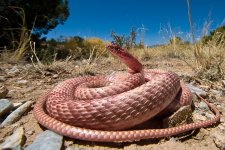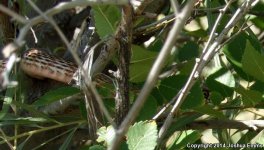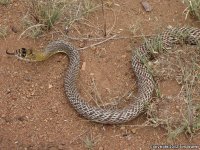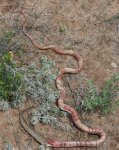| Range: |
 |
| Other Names: |
Whipsnake, Blotched Coachwhip, Coach |
| Subspecies: |
Lined Coachwhip Coluber flagellum linneatulus: Tan or light gray above, sometimes pinkish towards rear, each dorsal scale toward front of body with lengthwise streak. Salmon pink below, toward tail. Often yellowish to tan collar mark. Young with dark crossbands about 1 scale wide and a pale collar mark. Integrades with Western Coachwhip usually grayish or brown above, have fainter scale markings and yellowish ventral color.
Western Coachwhip Coluber flagellum testaceus: Tan, brown, pinkish to red above with dark narrow crossbands on neck (sometimes absent), may continue far toward rear. Some individuals are light-colored and lack pattern, others have a few broad (10-15 scales wide) crossbands. Cream below, with a double row of dark spots. Red phase most common in northern and eastern NM. |
| Description: |
Coachwhips are thin-bodied snakes with small heads and large eyes with round pupils. They vary greatly in color, but most reflect a proper camouflage for their natural habitat. M. f. testaceus is typically a shade of light brown with darker brown flecking, but in the western area of Texas, where the soil color is a shade of pink, the coachwhips are also pink in color. M. f. piceus was given its common name because specimens frequently, but not always, have some red in their coloration. Coachwhip scales are patterned so at first glance, the snake appears braided. Subspecies can be difficult to distinguish in areas where their ranges overlap. Adult sizes of 127-183 cm (50-72 in) are common. |
| Similar Species: |
The Sonoran Whipsnake and the Desert Striped Whipsnake are lined. The Racer and Green Rats never have dark crossbars on the dorsum, are bluish or greenish, never yellow or reddish and may be blotched (juveniles). Smooth Greens are vibrantly green, much smaller and usually found at higher elevations. |
| Venom: |
None |
| Habitat: |
Coachwhips are commonly found in open areas with sandy soil, open pine forests, old fields, and prairies. They thrive in sandhill scrub |
| Behavior: |
Coachwhips are diurnal, and actively hunt and eat lizards, small birds, and rodents. Coachwhips subdue prey by grasping and holding them with their jaws and do not use constriction. They tend to be sensitive to potential threats, and often bolt at the first sign of one; they are extremely fast-moving snakes. They are curious snakes with good eyesight, and are sometimes seen raising their heads above the level of the grass or rocks to see what is around them. Can slither up to 15 mph. They will bite if picked up. |
| Hibernation: |
Burrows and rock crevices, known to communal den with other species including but not limited to: Crotalus atrox, Crotalus viridis, Pituophis catenefir, Masticophis taeniatus |
| Reproduction: |
The coachwhip mates in early to mid-spring, after hibernating for the winter in a shallow underground retreat. In June, the mother snake lays some 12 to 18 eggs in a sequestered spot, for instance, beneath a fallen log, within a rotting tree trunk or in loose soil. She abandons the eggs, leaving them to incubate in the warmth of the spring sun. After a month and a half to three months, the eggs hatch, with 12- to 16-inch young emerging, completely reliant from the beginning on their own instincts for survival. |
| Diet: |
A formidable hunter, it feeds on prey such as small rodents, birds, bird eggs, reptiles (including venomous snakes) and insects. |
Sources:



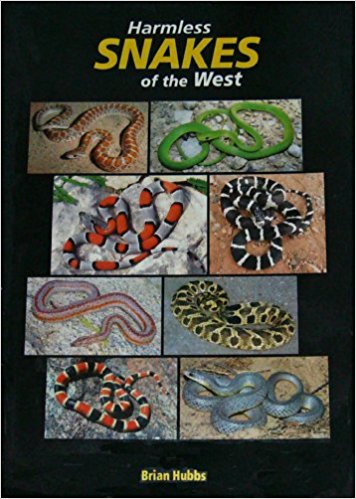

|






